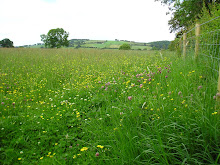


Telephone call asking if I would like a "nuc" [nucleus colony]from Tom results in a delightful drive in Hamish's van [thanks Hamish] up the beautiful Corvedale lanes last evening. Tom has been a beekeeper for over 50 years, he is "cutting back" and only has about 40 hives now! He understands every tic of nature's clock. Whilst we wait for the flying bees to return to the nuc we chat in the evening sunshine. A priceless opportunity to tap into the wisdom of so many years of experience. He used to think nothing of taking 20 hives in his Morris Minor Traveller up to some remote field to harvest honey from a particular crop. Its one of those occasions when I wish I had a digital recorder.
In no time half an hour passes, sun below the hilltops and most of the flying bees back so reluctantly we load up and head home.
First thing this morning I let the bees out to fly. Then mid, very warm, afternoon I take brood box number 3 down to the hive stand. The nuc is moved to one side, opened, and the frames carefully lifted in the same order into the brood box that is placed where the nuc had been. This should ensure that flying bees return to the right home. The remaining bees are shaken into the box and the nuc removed. Then a feeder is placed ontop and filled with syrup by way of a "welcome" feed.
Its a bit late in the season to take on a new colony. They will not produce honey for us this year but if the weather is kind there is a good chance that they can be built up sufficiently to survive the coming winter and set up a good start to next seasons crop. The pics show before during and after the transfer from nuc to brood box.





